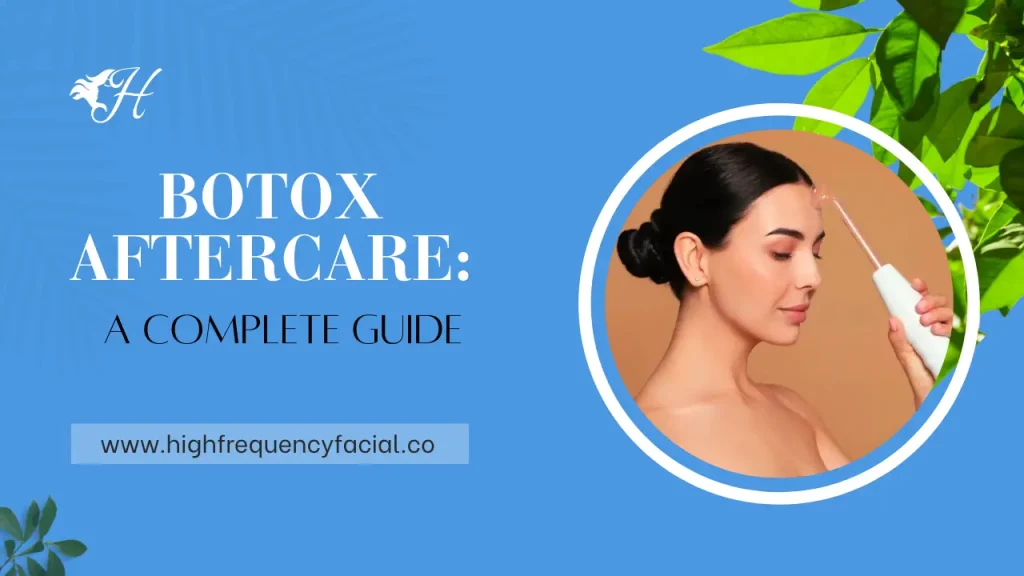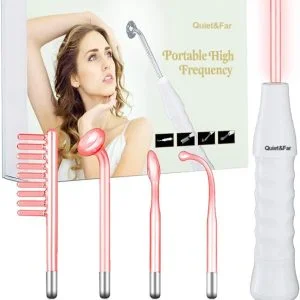The process of getting botox does not end after the treatment, the aftercare of it is as necessary as the treatment process is.
In this article, we’re diving into the essential aftercare routine for Botox , making sure you get the most out of your treatment.
We’ll break down the do’s and don’ts – Plus, we’ll explore the ins and outs of combining Botox with high-frequency treatments, tips on timing and precautions to maximize the benefits without compromising your Botox results.
It’s your go-to guide for easy, effective care for radiant and refreshed skin!


How Does Botox Work?
Botox, or Botulinum toxin, does its job by slowing down the messages sent from nerves to muscles.
When you get a Botox injection, it stops a chemical called acetylcholine from doing its usual work, which is telling the muscles to tighten up.
By putting a pause on this muscle signal, Botox helps the muscles relax. This is handy for smoothing out wrinkles because the skin above the relaxed muscle looks smoother. It’s a simple and effective way to temporarily reduce the appearance of lines, especially in areas like the forehead and around the eyes.
Keep in mind, though, that the effects wear off after a few months, so people often get repeat treatments for longer-lasting results.
Aftercare for Botox:
Here are the do’s and don’ts of after for botox:
| Do’s | Don’ts |
|---|---|
| Keep the treated areas clean and dry. | Avoid touching or rubbing the treated areas. |
| Stay in an upright position for at least four hours. | Do not lie down or bend over excessively. |
| Follow any specific aftercare instructions provided by your healthcare professional. | Avoid strenuous exercise or activities for 24 hours. |
| Use gentle skincare products on the treated areas. | Skip facial treatments like massages or laser therapy for a few days. |
| Attend follow-up appointments as scheduled. | Refrain from consuming alcohol for 24 hours. |
| Be patient and allow a few days for results to show. | Avoid blood-thinning medications or supplements for 24 hours. |
| Stay well-hydrated to support overall skin health. | Do not engage in excessive sun exposure or tanning. |
| Contact your healthcare provider with any concerns or questions. | Do not perform DIY facial treatments immediately after. |
| Put off other skin treatments. | Avoid prolonged sun exposure; relax in the shade. |
| Try to sleep on your back. | Ice can be applied to the treated areas if needed. |
| Exercise your face for 30 seconds, one hour after the treatment. | Wait for 24 hours after the treatment before engaging in strenuous exercise. |
Always consult with your healthcare professional for personalized advice based on your individual circumstances.


Can I Use High-Frequency Facial After Botox?
Applying high-frequency treatments directly in areas where fillers or botulinum toxin have been injected is not recommended. Doing so may diminish the longevity of the fillers or botulinum toxin treatment, potentially necessitating more frequent injections. It is crucial to avoid applying HF directly on top of these injected areas.
However, HF treatments can be safely applied near regions where fillers or botox have been administered without causing issues.
To ensure optimal results and safety, it is advisable to wait at least a week after receiving Botox before undergoing a high-frequency facial treatment. This precaution allows the Botox to settle properly, minimizing any potential interference with the treatment.
How Long Does Botox Last?
Botox results are typically not permanent and last for a temporary period. On average, the effects of Botox injections last around three to four months.
However, the duration can vary from person to person based on individual factors such as metabolism, muscle activity, and the specific area treated. It’s common for people to undergo periodic Botox treatments to maintain the desired results.
It’s crucial to follow up with your healthcare provider for scheduled appointments to ensure continuity in achieving the desired cosmetic effects.
What Are the Risks of Getting Botox?
While Botox is considered safe when administered by qualified healthcare professionals, it’s essential to be aware of potential risks and side effects. Here are some associated risks:
- Temporary Bruising or Swelling
- Headache
- Flu-like symptoms (rare)
- Drooping Eyelids or Brow (Incorrect injection placement can lead to temporary drooping of the eyelids or eyebrows.)
- Muscle Weakness (temporary)
- Allergic Reactions (rare)
- Difficulty Swallowing or Breathing (extremely rare)
How Quickly Does Botox Heal?
The onset of Botox results can vary, but generally, patients begin to notice changes within 3 to 7 days after the injection. The full effects may take up to 2 weeks to become fully apparent.
It’s important to be patient during this period, as the gradual onset allows for a more natural-looking outcome. If you have specific concerns or questions about the timeline for Botox healing, it’s advisable to discuss them with your healthcare provider, as individual responses may vary.
Can You Exercise After Botox?
Yes, you can exercise after receiving Botox injections, but it’s recommended to wait for at least 24 hours before engaging in vigorous physical activity.
This precaution allows the Botox to settle into the muscles properly and reduces the risk of the toxin spreading to unintended areas.
Gentle activities, such as walking or light stretching, are generally fine immediately after the procedure.
Conclusion:
To sum it up, Botox makes muscles relax by slowing down nerve signals. It’s a simple way to smooth lines for a few months, with repeat treatments for longer effects.
Aftercare involves avoiding exercise for a day and being cautious with high frequency near Botox areas. Understand the risks, like temporary bruising.
Noticeable changes happen in a week. Exercise is okay after 24 hours. Always check with your healthcare pro for personalized advice.





